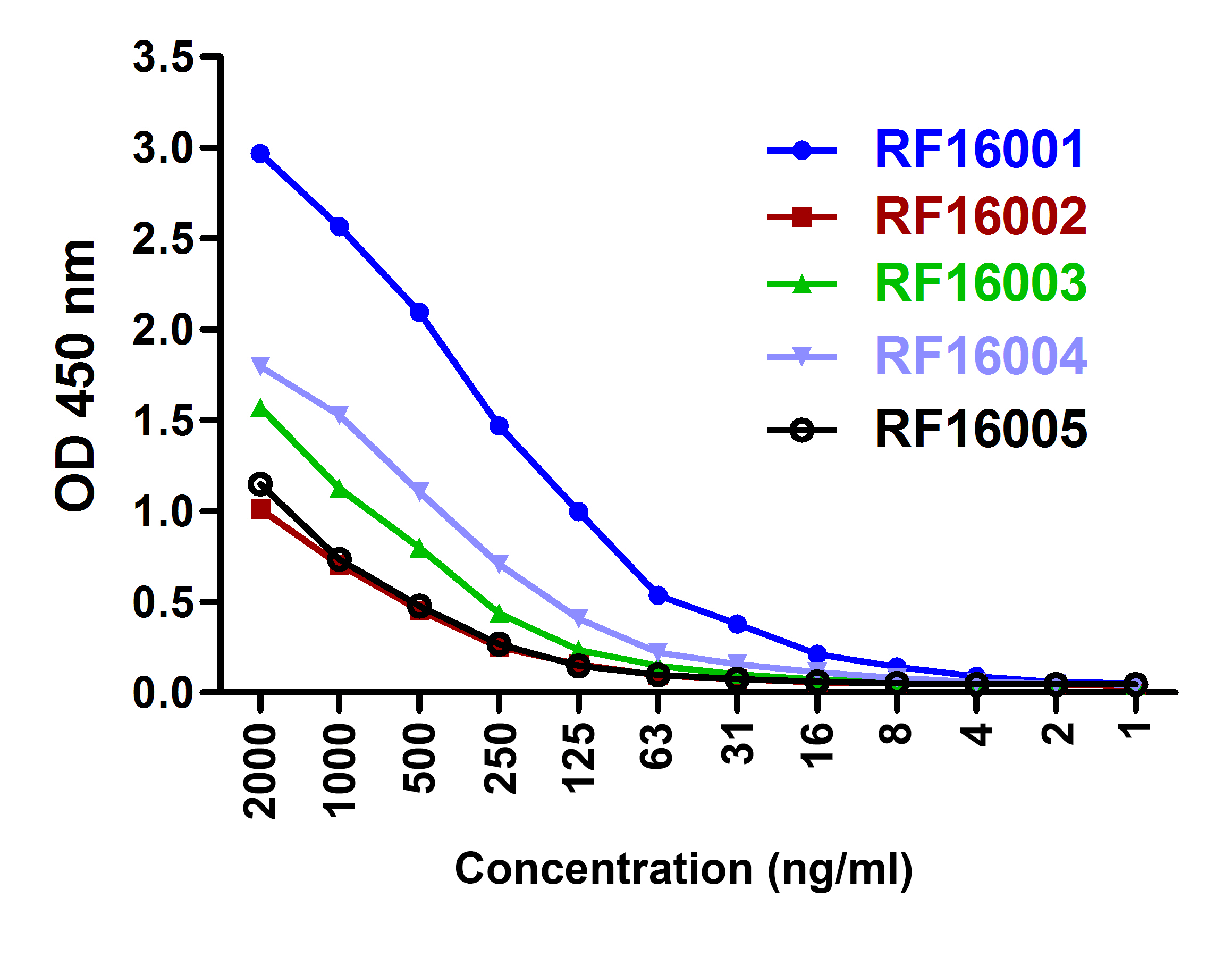PD1 Antibody [4C7]
| Code | Size | Price |
|---|
| PSI-RF16004-0.02mg | 0.02mg | £150.00 |
Quantity:
| PSI-RF16004-0.1mg | 0.1mg | £515.00 |
Quantity:
Prices exclude any Taxes / VAT
Overview
Host Type: Mouse
Antibody Isotype: IgG1
Antibody Clonality: Monoclonal
Antibody Clone: 4C7
Regulatory Status: RUO
Target Species: Human
Applications:
- Enzyme-Linked Immunosorbent Assay (ELISA)
- Flow Cytometry
- Immunocytochemistry (ICC)
- Immunofluorescence (IF)
- Immunohistochemistry- Paraffin Embedded (IHC-P)
- Western Blot (WB)
Shipping:
blue ice
Storage:
PD-1 antibody can be stored at 4˚C for three months and -20˚C, stable for up to one year. As with all antibodies care should be taken to avoid repeated freeze thaw cycles. Antibodies should not be exposed to prolonged high temperatures.
Images
Documents
Further Information
Additional Names:
PD-1 Antibody: PD1, PD-1, CD279, SLEB2, hPD-1, hPD-l, hSLE1, PD1, Programmed cell death protein 1, Protein PD-1, PDCD1, PDCD-1
Application Note:
PD-1 antibody can be used for detection of PD-1 by Western blot at 1 - 2 μg/mL. Antibody can also be used for immunohistochemistry starting at 5 μg/mL. For immunofluorescence start at 20 μg/mL. Flow cytometry at 0.1 μg/ml.
Antibody validated: Immunohistochemistry in human samples; Immunocytochemistry in human samples; Immunofluorescence in human samples and Flow Cytometry in human samples. All other applications and species not yet tested.
Antibody validated: Immunohistochemistry in human samples; Immunocytochemistry in human samples; Immunofluorescence in human samples and Flow Cytometry in human samples. All other applications and species not yet tested.
Background:
Cell-mediated immune responses are initiated by T lymphocytes that are themselves stimulated by cognate peptides bound to MHC molecules on antigen-presenting cells (APC). T-cell activation is generally self-limited as activated T cells express receptors such as PD-1 (also known as PDCD-1) that mediate inhibitory signals from the APC. PD-1 can bind two different but related ligands, PDL-1 and PDL-2. Upon binding to either of these ligands, signals generated by PD-1 inhibit the activation of the immune response in the absence of "danger signals" such as LPS or other molecules associated with bacteria or other pathogens. Evidence for this is seen in PD-1-null mice who exhibit hyperactivated immune systems and autoimmune diseases. PD-1 is thus one of a growing number of immune checkpoint proteins.
Background References:
- Holling TM, Schooten E, and van Den Elsing PJ. Function and regulation of MHC class II molecules in T-lymphocytes: of mice and men. Hum. Immunol. 2004; 65:282-90.
- Ishida Y, Agata Y, Shibahara K, et al. Induced expression of PD-1, a novel member of the immunoglobulin gene superfamily, upon programmed cell death. EMBO J. 1992; 11:3887-95.
- Zhong X, Bai C, Gao W, et al. Suppression of expression and function of negative immune regulator PD-1 by certain pattern recognition and cytokine receptor signals associated with immune system danger. Int. Immunol. 2004; 16:1181-8.
- Nishimura H, Nose M, Hiai H, et al. Development of lupus-like autoimmune diseases by the disruption of the PD-1 gene encoding an ITIM motif-carrying immunoreceptor. Immunity 1999; 11:141-51.
Buffer:
PD-1 Antibody is supplied in PBS containing 0.02% sodium azide and 50% glycerol.
Concentration:
1 mg/mL
Conjugate:
Unconjugated
DISCLAIMER:
Optimal dilutions/concentrations should be determined by the end user. The information provided is a guideline for product use. This product is for research use only.
Immunogen:
PD-1 antibody was raised against the extracellular domain of human PD-1.
NCBI Gene ID #:
5133
NCBI Official Name:
programmed cell death 1
NCBI Official Symbol:
PDCD1
NCBI Organism:
Homo sapiens
Physical State:
Liquid
PREDICTED MOLECULAR WEIGHT:
Predicted: 32 kDa
Observed: 38 kDa
Observed: 38 kDa
Protein Accession #:
NP_005009
Protein GI Number:
145559515
Purification:
PD-1 Antibody is supplied as protein A purified IgG1.
Research Area:
Immunology
Swissprot #:
Q15116
User NOte:
Optimal dilutions for each application to be determined by the researcher.


![Immunocytochemistry of PD-1 in transfected 293 cells with PD-1 [4C7] antibody at 10 μg/mL. Lower left: Immunocytochemistry in transfected 293 cells with control mouse IgG antibody at 10 μg/mL. Immunocytochemistry of PD-1 in transfected 293 cells with PD-1 [4C7] antibody at 10 μg/mL. Lower left: Immunocytochemistry in transfected 293 cells with control mouse IgG antibody at 10 μg/mL.](https://www.prosci-inc.com/static-images/PD-1-Antibody-4C7_ICC_RF16004.gif)
![(A) Immunohistochemistry of PD-1 in human breast cancer tissue with PD-1 [4C7] antibody at 10 μg/mL. (B) Immunohistochemistry in human breast cancer tissue with control mouse IgG staining at 10 μg/mL. (A) Immunohistochemistry of PD-1 in human breast cancer tissue with PD-1 [4C7] antibody at 10 μg/mL. (B) Immunohistochemistry in human breast cancer tissue with control mouse IgG staining at 10 μg/mL.](https://www.prosci-inc.com/static-images/PD-1-Antibody-4C7_IHC_RF16004.gif)
![Immunofluorescence of PD-1 in human breast cancer tissue with PD-1 [4C7] antibody at 10 μg/mL. <br><br>Green: PD1 Antibody [4C7] (RF16004) <br> Blue: DAPI staining Immunofluorescence of PD-1 in human breast cancer tissue with PD-1 [4C7] antibody at 10 μg/mL. <br><br>Green: PD1 Antibody [4C7] (RF16004) <br> Blue: DAPI staining](https://www.prosci-inc.com/static-images/PD-1-Antibody-4C7_IF_RF16004.gif)
![Flow cytometry analysis of PD-1 transfected 293 cells using PD-1 [4C7] antibody at 1 μg/ml. Blue: untransfected cells, Yellow: PD-1 transfected cells. Flow cytometry analysis of PD-1 transfected 293 cells using PD-1 [4C7] antibody at 1 μg/ml. Blue: untransfected cells, Yellow: PD-1 transfected cells.](https://www.prosci-inc.com/static-images/PD-1-Antibody-4C7_FACS_RF16004.jpg)


![Immunocytochemistry of PD-1 in transfected 293 cells with PD-1 [4C7] antibody at 10 μg/mL. Lower left: Immunocytochemistry in transfected 293 cells with control mouse IgG antibody at 10 μg/mL.](/images/blue_dot.png)